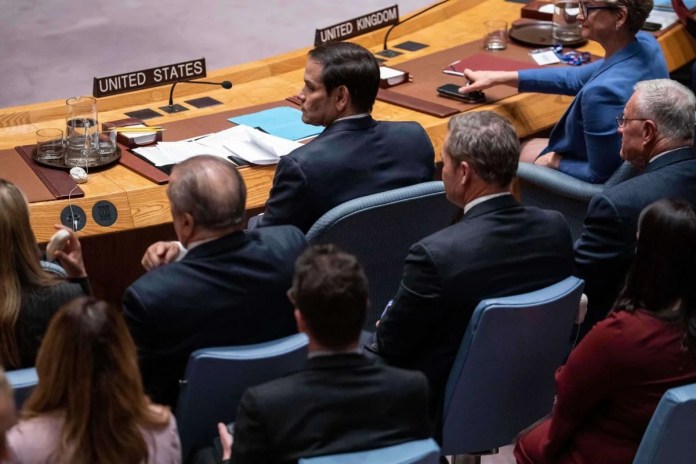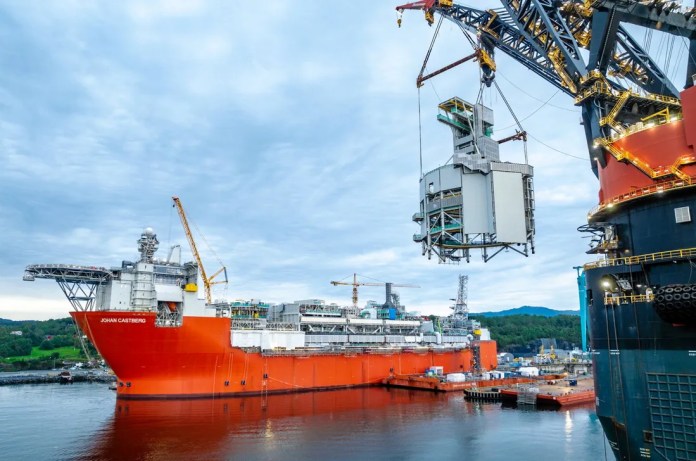London — Daniel Lee turned Burberry’s spring 2026 runway into a knowing love letter to Britain’s summer music culture, swapping pomp for grit and dialing up the festival romance with materials that shimmered in daylight and held shape after dusk. The set was a sky-blue marquee pitched on dirt, a deliberate nod to open-air stages and rain-or-shine optimism. The clothes answered the mood: skinny scarves drifting like guitar straps, glossy trenches cut short and sharp, crochet minis throwing light like mirrored cymbals, and boots that looked capable of surviving a weekend on grass and gravel.
Burberry’s show worked because it was less a costume party and more a field test. Instead of riffing on clichés, Lee pushed the brand’s signatures (trench, check, hardware) through a leaner, tougher silhouette. That shift away from the slouch and excess that dominated the last few years felt overdue. It also gave familiar icons new bite. A denim-effect waxed trench read as practical and subversive at once, while A-line versions in color-warped checks carried an echo of Mary Quant and West London mod without surrendering to retro cosplay.
Lee said the quiet part out loud both on the runway and backstage. The soundtrack skewed hard and nostalgic, and the tailoring moved from baggy toward razor-slim. Models in stacked rocker boots and tight jackets looked wired for a set change, not a red carpet. The intent felt unmistakable: Burberry would sell clothes for the everyday theater of queues, turnstiles, and train platforms, not just halo shots from VIP tents. That confidence translated into energy the house has been chasing since it began recalibrating after a turbulent stretch.

In clothes, the headline was texture. Crochet dresses, cut mostly short and occasionally skimming the knee, arrived tricked out with metallic discs, sequins, or chain details at the neck. A few were rendered in check meshes that caught the light like chainmail. Fringe framed everything from shoulder bags to scarf ends, swaying while the models took the narrow runway at speed. Leather was waxed, whipstitched, and occasionally perforated into paisley patterns that felt like souvenir posters turned tactile. Even the parkas wore their utility lightly: surplus-tinged, hooded, and bounded in branded webbing that kept the look grounded.
Accessories did heavy lifting. The skinny scarf (Lee’s calling card this season) was more than an accent; it was an anchor. Loop one over a blazer and the line of the torso snapped into focus. Toss it over a crochet mini and the look gained intent instead of preciousness. Bags came fringed or oversized, sometimes in pixelated checks, sometimes in bright leathers that flirted with psychedelic greens and purples. Footwear stayed pragmatic. Mid-calf boots with sturdy soles kept the styling honest, signaling that these clothes would live on sidewalks and festival grass rather than behind velvet ropes.

Color told its own story. The house check arrived remixed: less brown-beige nostalgia, more amplified hues blended into woven or weave-effect surfaces. Glossy apple green, bruise purple, and sunflower accents moved the palette away from earnest heritage and toward something livelier. Against the set’s painted-sky canopy, those colors read like a promise that British summer could, in fact, hold.
Structure mattered as much as surface. Short trenches cropped at the hip lengthened the leg and sharpened shoulders; a run of slim suits evoked the Beatles and the Small Faces without outright quotation; and bombers impressed with rising sun motifs along side stripes gave the lineup a subliminal narrative arc, culminating in tarot-printed trenches and scarves. The theme might have been festival, but the through-line was control. Silhouette, not spectacle, did the talking.

Celebrity casting and front row theater amplified the message without cheapening it. A cross-section of British culture lined the benches, media, sport, and fashion names leaning in, cameras perched, but the show never read as celebrity bait. If anything, it felt like a proof point that Lee understands who buys Burberry today and who might come back if the product is sharp, priced with discipline, and clearly British without being parochial. That energy linked cleanly with our recent read on celebrity looks setting early fall’s tone, where accessories and outerwear are doing the cultural heavy lifting.
For a brand that has spent the last year trimming sails, the strategic undertone mattered. Cutting back on overreach while doubling down on approachable icons is a credible turnaround formula. Scarves, reimagined checks, and adaptable outerwear meet shoppers where they are. Those are gateway products with a high wear count, and they travel well across regions and climates. The runway made a simple case: if Burberry can keep the line lean and the price ladders logical, the audience will climb. That same logic has animated peers, from Ralph Lauren’s Spring 2026 reset to Kering’s shake-up at Gucci under Francesca Bellettini.
That pragmatism extended to styling. Crochet might spark panic in the hands of a lesser team, but here it was scaled and finished for real life, mini lengths worn with grounded boots, mirror and medal details set firmly enough to avoid snag, slim jackets cinched to frame the knit rather than swallow it. Even when looks edged toward psychedelia, the components felt modular. You could pull the scarf and bag into a weekday uniform and save the dress for Saturday. That kind of versatility is how new-season mood boards become receipts. It echoed the street-grounded instincts on view at Coach at New York Fashion Week, where practicality sharpened the story rather than dulling it.
Lee’s Britishness (Yorkshire steel softened by London polish) kept showing up in small decisions. The trenches told the story most clearly. A suede version perforated with paisley felt cheeky rather than precious, as if the brand asked what would happen if paperback poetry met workwear. The waxed canvas parkas reminded the room that function is a heritage too. In a fashion month that will deliver no shortage of fantasy, Burberry’s grounded romance looked like a competitive advantage.
There were moments of unabashed theatrics. Tarot prints threw a wink at fate and fandom. Fringed collars and whipstitched edges pushed into outlaw territory just enough to break the baptismal neatness of spring collections. A few mini kilts iced in sequins played with light in a way that made sense under that painted sky. Nothing felt random. The editing was tight, the casting made the clothes look fast, and the pacing kept the audience leaning forward.
For those keeping score on the arc of silhouette, this season placed a clear bet on smaller and sharper. Oversize has had a long run; a correction always comes. Slim jackets, lean trousers, cropped trenches, and those slinky scarves telegraphed a recalibration without tipping into pencil-thin austerity. The result was modern rather than nostalgic, music history used as a tuning fork, not a time machine.
If the brand’s recent history hovered in the background, it was only to illustrate how quickly the mood can change when the clothes line up. A house that lives on outerwear needs seasonal storylines that honor that DNA and invite participation at multiple price points. This lineup did both. Scarves can be an entry; boots can be a commitment; trenches are the forever piece. Checks, now remixed, pull the whole thing together like a chorus you can hum on the way out.
One measure of success at a heritage house is whether the icons feel inevitable rather than obligatory. On that count, Burberry landed the plane. The check did not lecture. The trench did not sermonize. The hardware did not overcompensate. Instead, the vocabulary updated itself in real time, slotting into the larger conversation in London this week about craft meeting commerce. Look by look, the show argued that British style can be both romantic and unsentimental, both local and global, both ready for a field and ready for a flight. For more of that push-pull in London, see our Chopova Lowena review, where cheerleader kitsch snapped into sharp street.
It also argued, persuasively, that festival dressing has earned its place in the luxury canon. Not the plasticized, disposable kind, but the tough, artful, self-mythologizing kind that British summers have always nurtured. Clothes designed to get dusty. Clothes that take to polish and patina. Clothes you can pack for a train north or a ferry west. That is the version of Britishness Lee sent down the runway, and it looked convincing.
By the time the models made their final circuit, the thesis was clear. Music culture is not a garnish here; it is the main ingredient. The garments were instruments, the silhouettes a tempo change, the accessories a chorus. If the next few seasons keep tuning along these lines (less nostalgia drag, more present tense), Burberry will have translated mood into momentum. In a crowded market chasing the same handful of talking points, this felt like a distinct voice.
According to Burberry plc, the show returned to Perks Field in Kensington Gardens and unfolded beneath a cloud-painted, sky-blue marquee; official materials confirm the set concept, venue and soundtrack direction for the runway. Set imagery and tent specifics were further reported by W Magazine, while Designboom documented the earth-toned floor and cube-shaped seating that framed the dirt-covered runway.
According to WWD and cataloged by Vogue Runway, the collection prioritized cropped trenches, lean tailoring, rocker-boot styling and skinny scarves as a recurring motif. London Fashion Week timing and framing came via the British Fashion Council, which set the September 2025 season for 18–22 September, and the strategic backdrop for Burberry’s reboot—focused on pricing discipline, core icons and a tighter edit—was analyzed by the Business of Fashion.






































